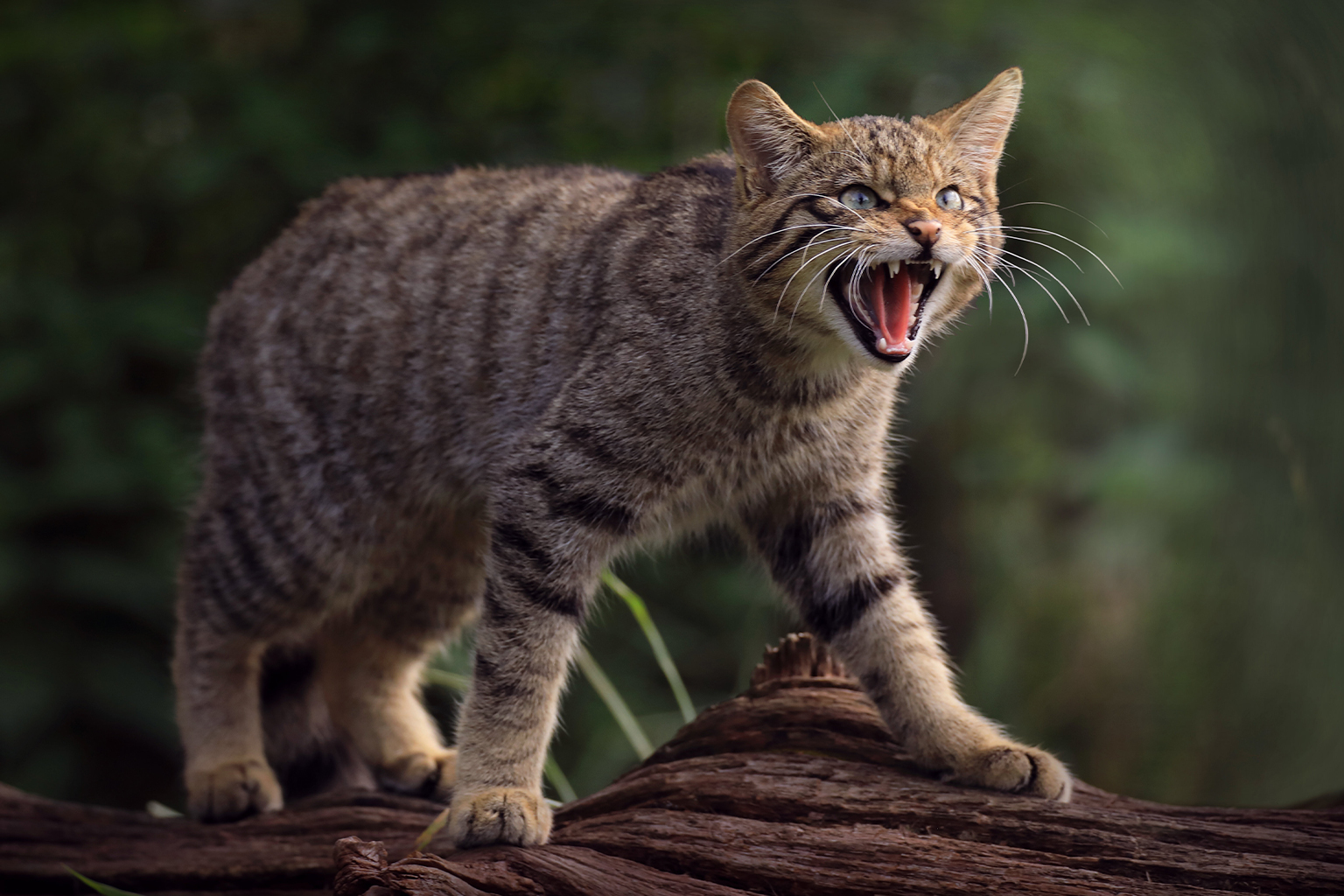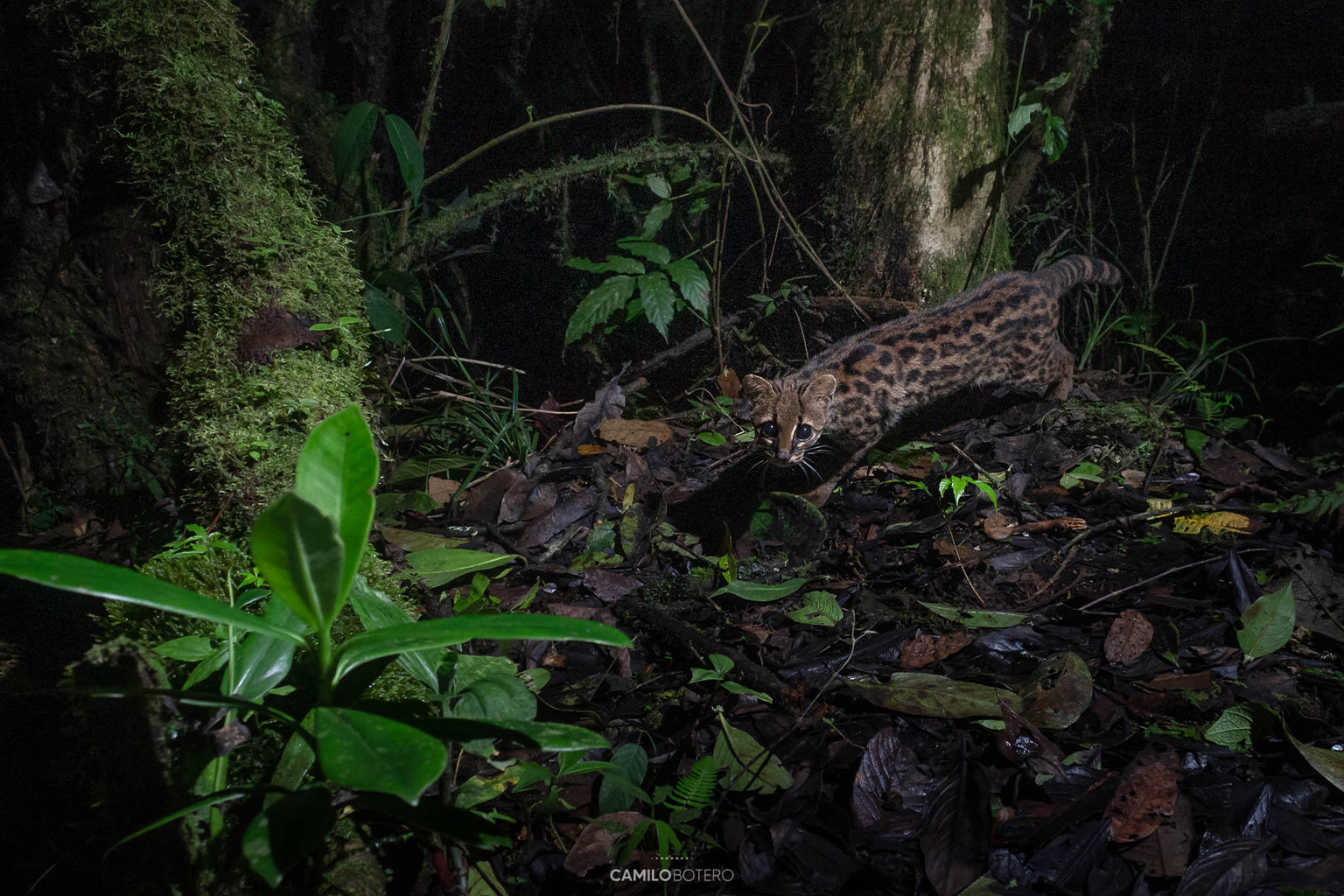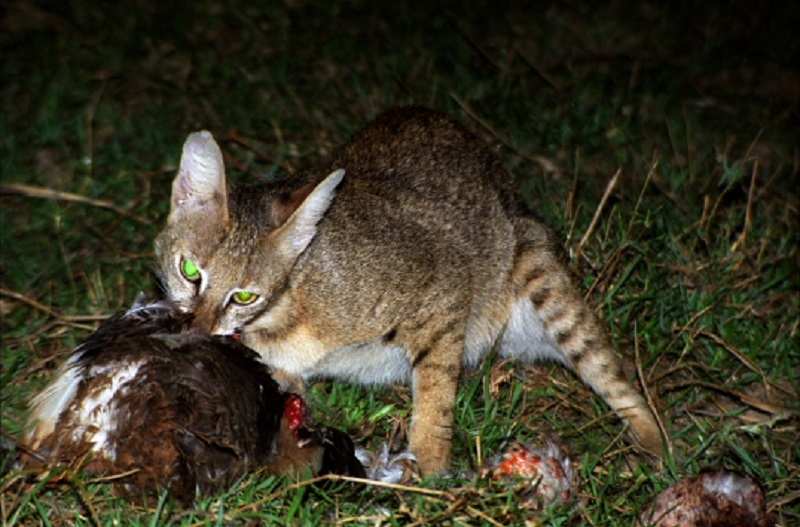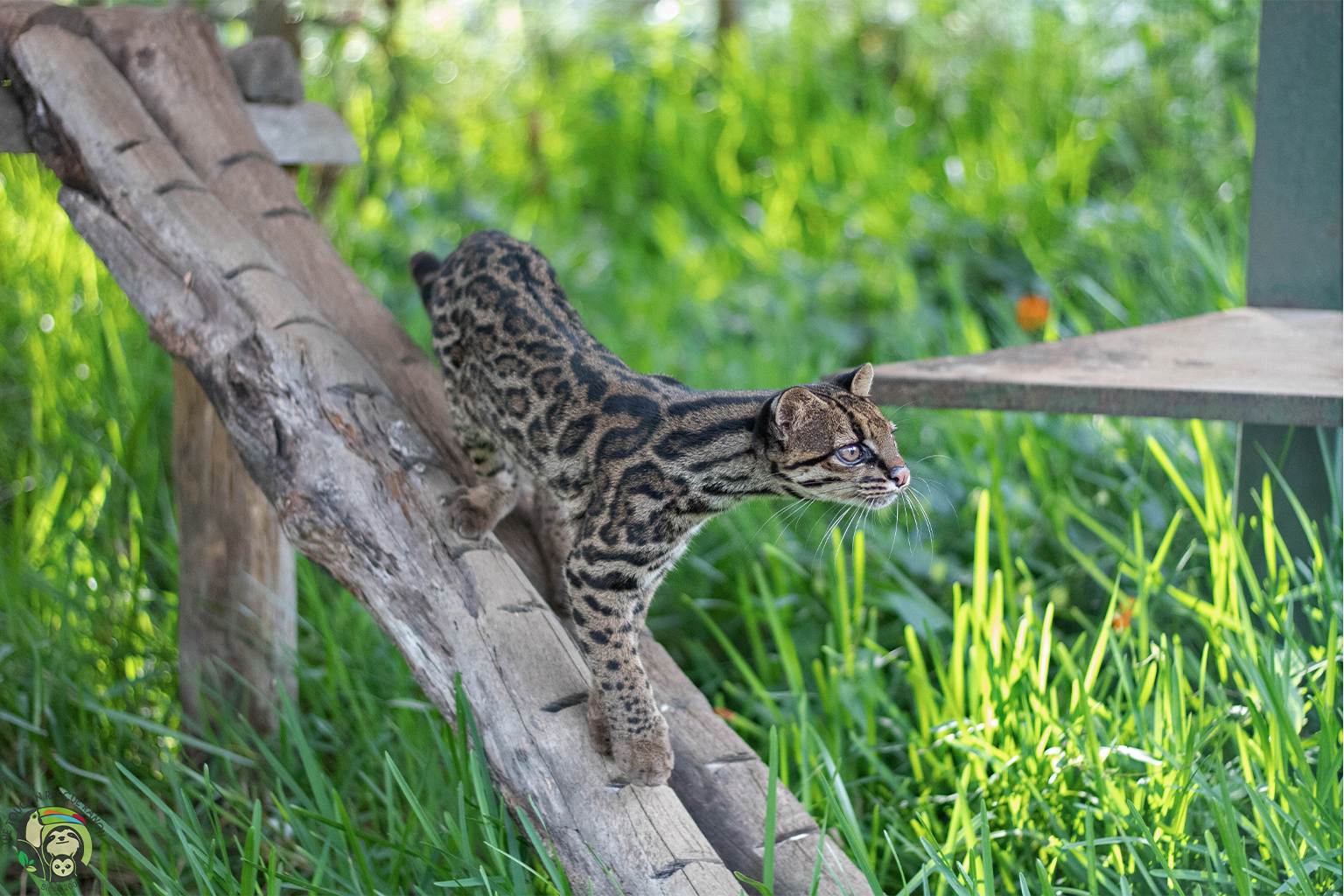- Though lesser known than big cats, such as tigers or snow leopards, more than 30 species of small cats roam the world. They’re well adapted to drastically different habitats, as varied as South America’s high Andes and Asia’s coastal wetlands. Though stealthy and largely unseen, they have value to ecosystems and humanity.
- Generalist small felid species, such as the jungle cat and leopard cat, can thrive in disturbed or agricultural landscapes. There, researchers say, they can significantly aid farmers by reducing rodent populations.
- Small cats also play a key role in maintaining ecosystem health by controlling small mammal populations in the wild.
- Conservationists believe small cat species could make ideal candidates for both conservation and restoration in the global push for the rewilding of nature.
In Scotland, the population of the country’s wildcats (Felis silvestris silvestris) has dwindled so much they’re now considered functionally extinct. There are fewer than 30 Scottish wildcats, also known as the Highland tiger, left in the wild. Conservationists are rushing to save the species through a reintroduction programme set to kick off later this year.
A combination of habitat loss, persecution and most recently, hybridisation with domestic cats drove the species to its current crisis point. But the Highland tiger isn’t alone in its predicament, and it can be seen as a possible indicator of looming ecosystem collapse: The United Kingdom is one of the most nature-depleted places on Earth.
Bringing the Scottish wildcat back could have a plethora of benefits, says Richard Bunting, a spokesperson for the Scottish Rewilding Alliance. The Highland cat, along with small cats the world over, plays a key ecological role by controlling small mammal populations in their natural habitats. Many cats, though maligned, also aid farmers by reducing rodents. In Scotland, the cat’s return could also boost local economies through activities such as wildlife observation and ecotourism.

“What I would like to see is the restoration of wild cats, like the Scottish wildcat, driving better [habitat] quality and better-connected ecosystems,” says Helen Senn, programme manager at the Royal Zoological Society of Scotland.
Researchers and conservationists like Senn, underline another key reason behind the often-imperiled state of small cats globally: They largely roam beneath the public and policy radar, moving stealthily and unseen across the landscape. So, they remain understudied, with their key conservation status not fully explored and underfunded.
A fuller understanding of the key roles these wild felid species play in maintaining healthy ecosystems and how their presence benefits people could help put small cats in the conservation spotlight in time to prevent some species blinking out of existence.

Small cats around the world
A remarkable range of wild felid diversity and adaptability exists under the umbrella of “small cats,” an imprecise label that differentiates them from “big cats” such as lions, tigers and jaguars.
Small cats range in size from South Asia’s diminutive rusty-spotted cat (Prionailurus rubiginosus), which, at 0.8-1.6 kilograms (1.8-3.5 pounds), is the world’s smallest wild felid; to the far larger two species of clouded leopard (Neofelis diardi and N. nebulosa). Weighing in at up to 23 kg (50 lbs), clouded leopards are often referred to as modern-day saber-toothed tigers and ambiguously classified as “big small cats” by some or “small big cats” by others.
This expansive group of reclusive felids inhabits an astounding range of habitats, from deserts and savanna grasslands to tropical and temperate forests, enlivening alpine heights and low coastal wetlands as well as human-dominated agricultural landscapes.
“Each of these small cat species is uniquely adapted to survive within its habitat type and serve important ecological roles,” says Priya Singh, a wildlife researcher in India. “However, given their small sizes and inconspicuous behaviour, they often get neglected by conservation initiatives or wildlife management plans.”

Like their big cat cousins, these smaller species face a host of threats including habitat loss and fragmentation, persecution due to human-wildlife conflict, climate change, diseases spread by domestic animals, the risk of becoming road kill and pollution, including plastics ingestion in some cases. Of the more than 30 small cat species, a dozen are currently considered threatened or endangered by the IUCN, including the African golden cat (Caracal aurata), Andean cat (Leopardus jacobita), Borneo bay cat (Catopuma badia), Black-footed cat (Felis negripes), Chinese mountain cat (F. bieti), fishing cat (P. viverrinus), Flat-headed cat (P. planiceps), Guiña (L. guigna), the northern and southern tiger cat (L. tigrinus and L. guttulus) and both species of clouded leopard. Recently, researchers called for the semi-arboreal marbled cat (Pardofelis marmorata) to be added to the list.
Conservationists underline that these cats — being small and midlevel predators — play an invaluable role in maintaining ecosystem health, controlling prey and disease and thereby benefiting human communities across the globe.

Small cats help sustain healthy ecosystems — but how much?
Pallas’ cat (Otocolobus manul), or Manul, became a small cat super star when it was described as the “grumpiest cat in world” by naturalist and presenter David Attenborough. When not starring in cute memes or grouchy GIFs, Pallas’ cat roams the steppes of Central Asia and helps maintain the health of the grassland habitat via its dietary habits, as it preys upon pika and other small rodents.
The ecological well-being of this vast landscape is vital to local people, especially pastoral farmers. And more recently it became critically important nationally due to the recognition of the steppe’s value as a carbon sink, Emma Nygren, head of conservation programs at the Pallas’s Cat International Conservation Alliance, writes in an email.
“Conservation of the Pallas’ cat not only helps us protect an iconic small cat species of Central Asia, but also has an indirect role in protecting the steppe grassland,” Nygren says. While the small cat’s ecosystem maintenance role could be major, it’s extent still isn’t fully known.

The Andean cat, Latin America’s most endangered wild felid, is well-equipped to thrive in harsh environments. “Its large tail helps it chase down vizcachas [rodents resembling rabbits]. Its thick, fluffy coat helps it survive the cold, and it seems to be able to survive well with very little water,” says Anthony Gerardo Pino Charaja, a biologist and communications coordinator for the Andean Cat Alliance.
However, “I can’t say that if the Andean cat goes extinct, this or that is going to happen. But if [something bad] happens, we won’t know until it’s too late,” he adds. “It’s not like the tropical forests where if a species disappears, another can take its place [occupying its same niche] to an extent.”
Without small cats, the ecosystems in which they dwell “will definitely be poorer,” as they would likely see significant changes, especially explosions in small mammal and rodent numbers, Tiasa Adhya, an India-based co-founder of the Fishing Cat Project, writes in an email. But again, because of the general lack of research, “What effect [small cat extinction] would have on the ecosystem one can only hypothesise.”
Adhya’s group focuses on the fishing cat, a wetland specialist found in Asia that not only eats fish but also birds, small mammals and reptiles. “It can thus be assumed that the [species] plays an important role in maintaining food web dynamics in ecosystems,” Adhya writes, adding that the fishing cat likely also aids in recycling wetlands nutrients.

Read more: Hope in sight for the ambassador of Chilika lake, the elusive fishing cat
In an increasingly nature-depleted world, amid an escalating global biodiversity crisis, the role of smaller carnivores can, in some instances, be heightened when larger predators are wiped out. In Africa’s equatorial forest, for example, the African golden cat — a species once described as the continent’s least known cat — offers signs of being just such a case, says Badru Mugerwa of the conservation organisation Embaka. Leopards and African golden cats once roamed together through Africa’s forests, covering a large range. But with the decline of the leopard, the golden cat has now become one of the largest forest-dwelling predators in some places, including Bwindi Impenetrable National Park in Uganda. “In areas where the leopard is absent, the African golden cat often goes for bigger prey, such as small antelopes, or forest duikers,” Mugerwa says. But, “When you go to areas where the leopard is still present, the African golden cat feeds mostly on small rodents.”
A study released last year argues that some small cats — along with other small carnivores — could act as important bellwethers of ecosystem health, possibly more so than their big cat cousins. That’s because some of these small cats are specialists and can experience a greater sensitivity to changes, with their precipitous decline serving as strong indicators of failing ecosystem health, says Wai-Ming Wong, director of Panthera’s Small Cats Program.
“For some of the small cats that have these very specialised habitat niches, if you make any small changes, they don’t really have anywhere else to go,” he explains.


“A free colleague” serving farmers
The ecological role of small cats in their natural habitat can greatly benefit people, with some experts even calling them a “free colleague” to farmers and other rural people.
Santanu Mahato grew up in an agricultural-dominated landscape in India, and from a young age he regularly spotted the jungle cat, or golden jackal, hanging around farmlands. “I didn’t notice or observe them in a scientific way, or the way we see them as a researcher,” he says.
As a biologist, he set out to study the interactions of the jungle cat on farmers’ land, investigating the varied roles they play in pastoral landscapes. Based on limited studies in India, each jungle cat is now thought to consume at least 3-5 rodents per day, possibly gobbling down as many as 1,000 per year.
But like other small cats, jungle cats will readily catch chickens. This behaviour can bring them into direct conflict with people and shift perceptions against them. However, after analysing scat samples, Mahato found that the jungle cat predominantly feasts on rats, a trait that benefits local people, though it’s one that few recognised, he says.
Instead, people viewed the sometimes chicken-eating cats as pests. Practicing peaceful coexistence with the jungle cats, along with other small carnivores, he suggests, would likely result in less damage to important crops.

These jungle cat findings are echoed by other research. The highly adaptable leopard cat (P. bengalensis) is often present on oil palm plantations in Southeast Asia, where it mostly preys on rodents. Researchers argue that maintaining “biological pest controllers” of this kind can enable farmers to reduce the use of harmful chemical pesticides and cut agricultural costs.
“Our work with leopard cats has really shown that it is better to do a proper biological assessment of what is already in place, and utilise these [wild] species as pest controllers by enriching their habitat,” Carl Traeholt, Southeast Asia program director at Copenhagen Zoo, writes in an email. “Leopard cats are especially effective because they are opportunistic, whereas most other small cats are not found in a plantation at all.”
Half a world away, in the United States, wild cat conservation organisation Panthera is launching a research project to understand the role bobcats play in controlling mountain beavers, which cause millions of dollars in damage to foresters’ lands in Washington state. Maintaining bobcat populations could help keep the beavers in check, Wong says.
Understanding the ecological role of small cats and educating people to their economic benefits could be a gateway to changing hearts and minds about species that are often maligned, considered pests and killed, say researchers.


“Flagships” for nature and rewilding
Though many threats to wild felids can be complex and problematic, some, such as conflict with humans, can be easier to resolve than with bigger cats, say experts. That fact offers hope for smaller wild felids.
Maintaining these populations is vital, say conservationists, who warn that so little is known about many small cat species that they could be serving vital ecological functions we’ve yet to discern. The elusive flat-headed cat and Borneo bay cat offer two such examples. “It would be prudent to conserve [them] while we still have the chance,” Adhya writes.
Aside from their underappreciated pest control capacity, and their positive influence on ecosystem food chains, small cats could serve an even greater, broader, and still mostly unrecognised role in conservation, Luke Hunter, executive director of Big Cats Program at the Wildlife Conservation Society, tells Mongabay in an interview.
“Big cats offer a really good umbrella for conservation,” because they engender so much public support and interest, he says. “But I think there’s something to be valued in small cats, which often isn’t [recognised]. They can have huge potential as a secondary [conservation] backup.”
They could potentially serve as “flagships” to help promote conservation in areas devoid of big charismatic species, say other experts: The fishing cat or flat-headed cat could, for example, become the face of threatened wetlands. Ocelots or margays could play the role of flagships in forests, where bigger cats may not roam, while the acrobatic serval cat could be an additional ambassador for African grasslands.

Echoing Bunting and Senn’s assertion that the Highland tiger could become the feline face of Scotland’s drive to rewild, Wong sees similar potential for small cats everywhere. “I think some small cats can make a really great candidate for that [flagship role] because they already occur outside of protected areas in human dominated landscapes,” he says.
In the case of Scotland’s reintroduction, success remains uncertain. But conservationists are buoyed by the comeback of the Iberian lynx in Spain, where the small cat rebounded from just 200 or so individuals in the wild near the start of the 21st century to more than 1,300 today.
Senn thinks Scotland’s wildcat experience offers lessons for global conservation. “It’s important that people care as much about small cats as they do about big cats, and that we continue to fill all the knowledge gaps to make sure we’re doing our best to monitor populations,” she says. Effective conservation interventions need to take place early on, before it’s too late; “which is unfortunately where we’ve got to with wildcats in Scotland.”
Read more: Hidden cameras reveal six colour variants of the Asiatic golden cat
CITATION:
Breitenmoser, U., Lanz, T., & Breitenmoser-Würsten, C. (2019). Conservation of the wildcat (Felis silvestris) in Scotland: Review of the conservation status and assessment of conservation activities. Retrieved from IUCN SSC Cat Specialist Group, Scottish Wildcat Conservation Action Plan Steering Group website: https://www.nature.scot/sites/default/files/2019-02/Wildcat%20in%20Scotland%20-%20Review%20of%20conservation%20status%20and%20activities_1.pdf
Zhao, D., Yang, C., Ma, J., Zhang, X., & Ran, J. (2020). Vertebrate prey composition analysis of the Pallas’s cat (Otocolobus manul) in the Gongga Mountain Nature Reserve, based on fecal DNA. Mammalia. Retrieved from https://www.degruyter.com/document/doi/10.1515/mammalia-2018-0144/html
Bahaa-el-din, L., Henschel, P., Butynski, T. M., Macdonald, D. W., Mills, D., Slotow, R., & Hunter, L. (2014). The African golden catC<i>aracal aurata</i>: Africa’s least-known felid. Mammal Review, 45(1), 63-77. doi:10.1111/mam.12033
Marneweck, C. J., Allen, B. L., Butler, A. R., Do Linh San, E., Harris, S. N., Jensen, A. J., … Jachowski, D. S. (2022). Middle-out Ecology: small carnivores as sentinels of global change. Mammal Review, 52(4), 471-479. doi:10.1111/mam.12300
Mahato, S., Ghosh, T., Sinha, S. K., Yardi, K., & Bharucha, E. (2022). Jungle cat (Felis chaus) in farmlands: Potential benefits of coexistence and human-wildlife conflicts in West Bengal, India. Ethology Ecology & Evolution, 1-16. doi:10.1080/03949370.2022.2152102
Mukherjee, S., Goyal, S. P., Johnsingh, A. J., & Pitman, M. R. (2004). The importance of rodents in the diet of jungle cat ( Felis chaus ), caracal (Caracal caracal) and golden jackal ( <i>Canis aureus</i> ) in Sariska tiger reserve, Rajasthan, India. Journal of Zoology, 262(4), 405-411. doi:10.1017/s0952836903004783
Silmi, M., Mislan, M., Anggara, S., & Dahlen, B. (2013). Using leopard cats (Prionailurus bengalensis) as biological pest control of rats in a palm oil plantation. Journal of Indonesian Natural History. Retrieved from http://jinh.fmipa.unand.ac.id/index.php/jinh/article/view/9
Silmi, M., Putra, K., Amran, A., Huda, M., Fanani, A. F., Galdikas, B. M., … Traeholt, C. (2021). Activity and ranging behavior of Leopard cats (Prionailurus bengalensis) in an oil palm landscape. Frontiers in Environmental Science, 9. doi:10.3389/fenvs.2021.651939
Rasphone, A., Bousa, A., Vongkhamheng, C., Kamler, J. F., Johnson, A., & Macdonald, D. W. (2022). Diet and prey selection of clouded leopards and tigers in Laos. Ecology and Evolution, 12(7). doi:10.1002/ece3.9067
Elbroch, L. M., Robertson, L., Combs, K., & Fitzgerald, J. (2017). Contrasting bobcat values. Biodiversity and Conservation, 26(12), 2987-2992. doi:10.1007/s10531-017-1397-6
This article was first published in Mongabay.com
Banner image: Clouded leopards prey upon a range of species including wild pigs and ungulates, helping control forest populations. Photo by Charlie Marshall / Flickr.
